
There are two species of anaconda in the Amazon basin. The Great Water Boa and the Yellow Boa. Both are members of the family Boidae and belong to the genus Eunectes. Anaconda are types of boa constrictor and catch their food by grabbing them and then squeezing them to death like any other constrictor.
 |
We were coming back from a day trip when we had to pass under a log. As we were passing, Robinson yelled then jumped off the boat and began to grab at the tree. The next thing we knew he was climbing back into the boat with a live anaconda. What none of us expected was the way that the snake would try to protect itself--it promptly began to (how should I say this delicately?) poop all over the place with smelly, watery, yellow stuff. I think that most normal people would have dropped it but Robinson held on and we brought it home with us. |
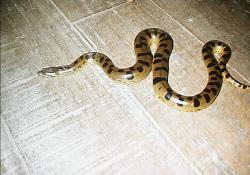 |
We let the anaconda crawl around the floor of the dining lodge for the rest of the night. While it wasn't dangerous, you had to watch out so you didn't step on it. The snake was released in a side stream the next day. |
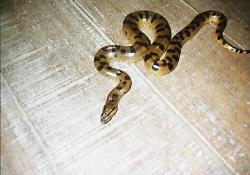 |
This was a juvenile great water boa. While he was only a couple of feet long, but undisturbed, he will grow to 5 meters (16 feet) or more. He is a beautiful green-yellow with oval black spots. He is at home in the water, along the banks and can even climb trees to search for food. Anaconda eat most anything they can find from small birds to rats to small mammals. A full-grown snake can weigh hundreds of pounds. |
All of us had to pick up and play with the snake. Notice the difference in pattern between the top of the snake and the bottom. |
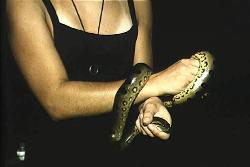 |
Early one morning while we were out watching birds, our guide yelled to some people he knew on the bank. The people had caught a large anaconda the day before, killed it and they were preparing the skin for a display in their house. The biggest threat to these snakes is from man. Large snakes that are discovered are almost always killed as trophies and the population is declining. |
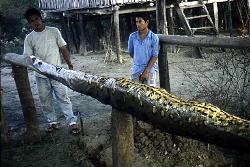 |
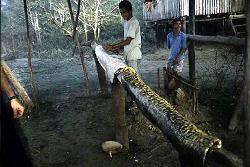 |
The skin is stripped of meat and allowed to dry. The meat is considered inedible and is thrown away. This specimen is a female and had 34 eggs inside her when she was killed. The anaconda is ovoviparous which means that it has eggs that inside that hatch and then the baby snakes are "born" live. |